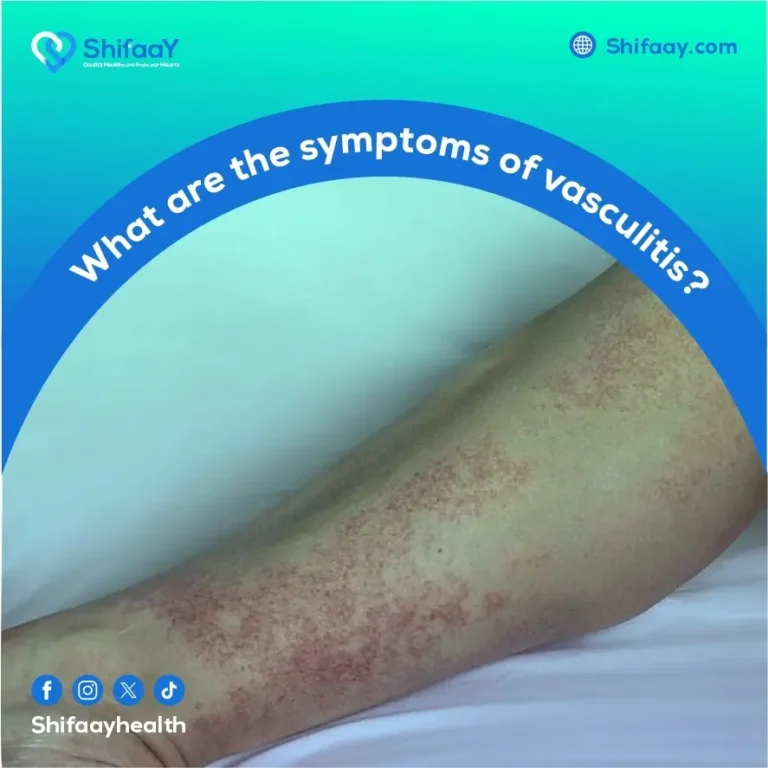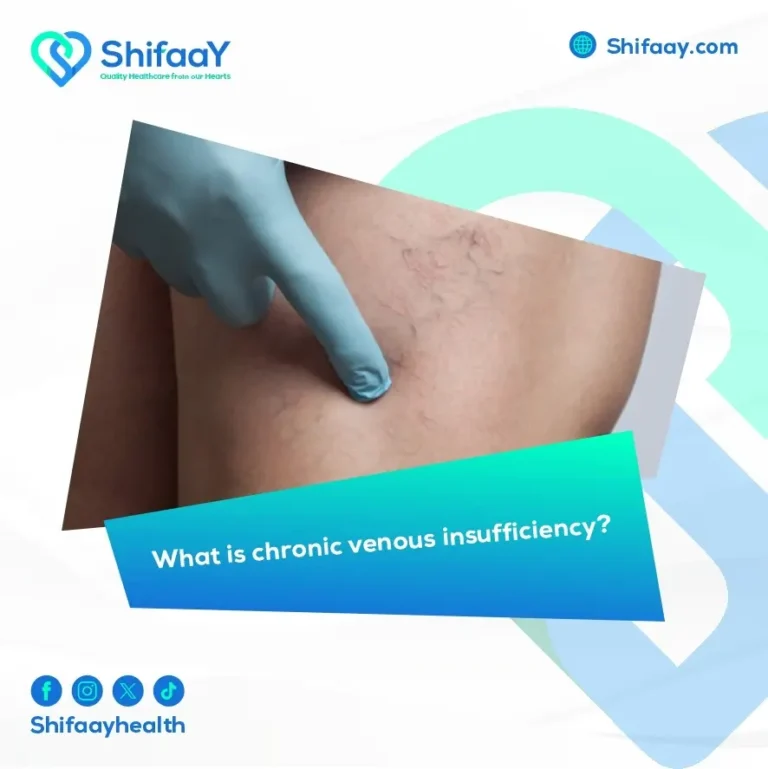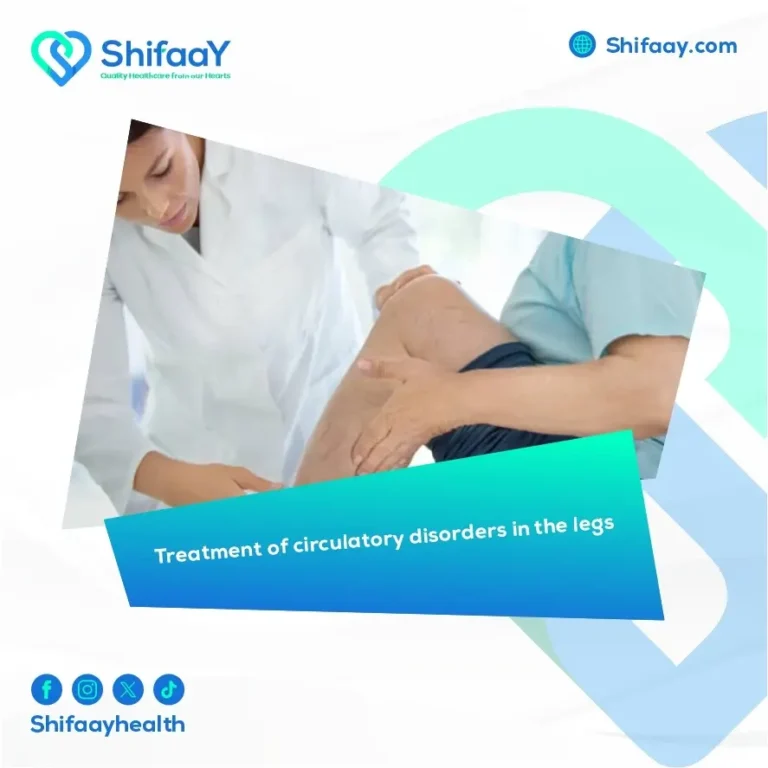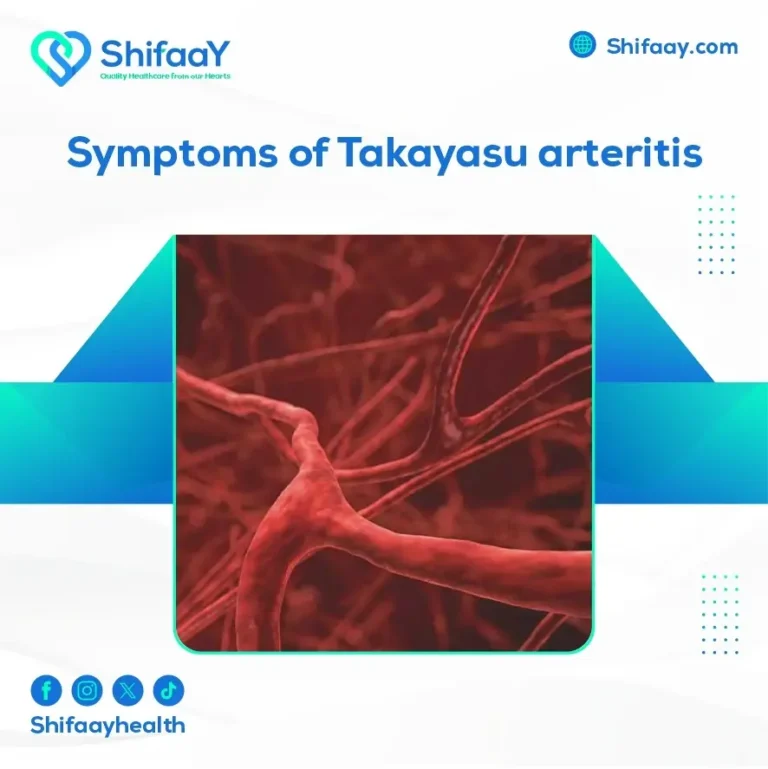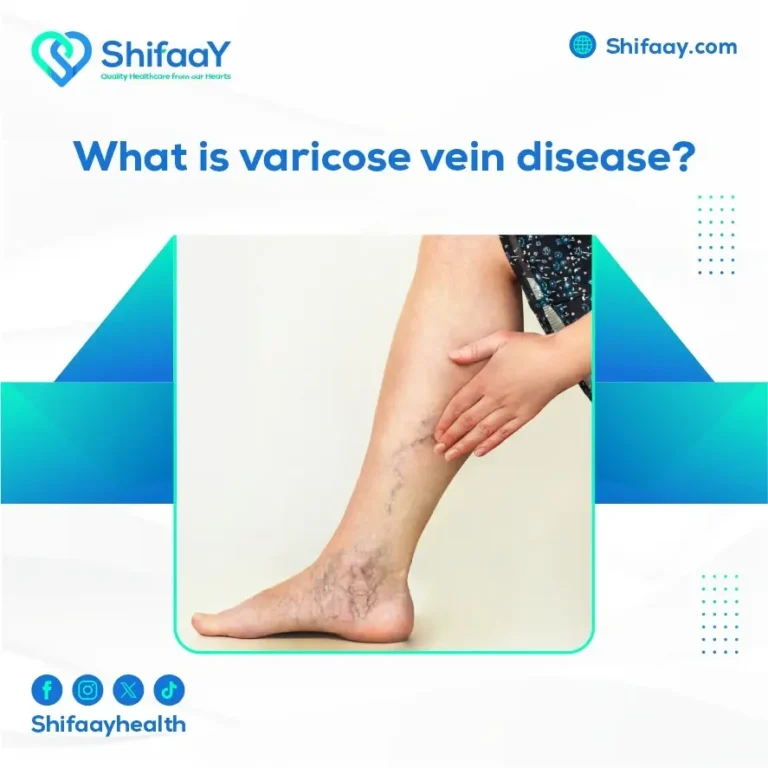Early Signs of a Blood Clot
In a world where the pace of life is rapidly accelerating and daily pressures are constantly increasing, many people tend to overlook warning signs that may indicate the presence of a serious health risk silently developing inside their bodies. Among these risks are the symptoms of blood clots—considered one of the most mysterious and dangerous medical conditions. Blood clots often form without prior warning and typically manifest with symptoms that some might dismiss as minor or non-threatening, such as unexplained swelling in a limb, persistent leg pain, or even sudden shortness of breath.
What makes this condition particularly dangerous is its ability to migrate from its point of origin—commonly the deep veins of the leg—to vital organs such as the lungs or brain. This can lead to life-threatening complications like pulmonary embolism or stroke. Therefore, early recognition of these signs and taking them seriously can make a major difference in prevention and treatment, and could potentially spare the patient from severe health consequences.
Although blood clot symptoms may vary depending on their location in the body, there are certain common warning signs that must not be ignored. For instance, if you experience sudden swelling in the leg or arm, or notice discoloration of the skin turning bluish or purplish, this could indicate a deep vein thrombosis (DVT). Persistent pain, localized warmth, and restricted movement in the affected area are additional warning signs that require attention.
In more severe cases, the clot may travel to the lungs, resulting in symptoms such as shortness of breath, chest pain that worsens with deep breaths, and a rapid heartbeat.
Sometimes, a stroke may result from a clot traveling to the brain. In such cases, warning signs may include difficulty speaking, paralysis of part of the face or body, and sudden loss of balance or vision. These are all emergency indicators requiring immediate medical intervention, as any delay in responding to blood clot symptoms can lead to permanent brain damage or even death. This is why it is crucial for everyone to understand that time is a critical factor in such cases—seeking medical care within minutes or hours of symptom onset can significantly reduce the extent of damage and increase the chances of full recovery.
Mild Blood Clot Symptoms
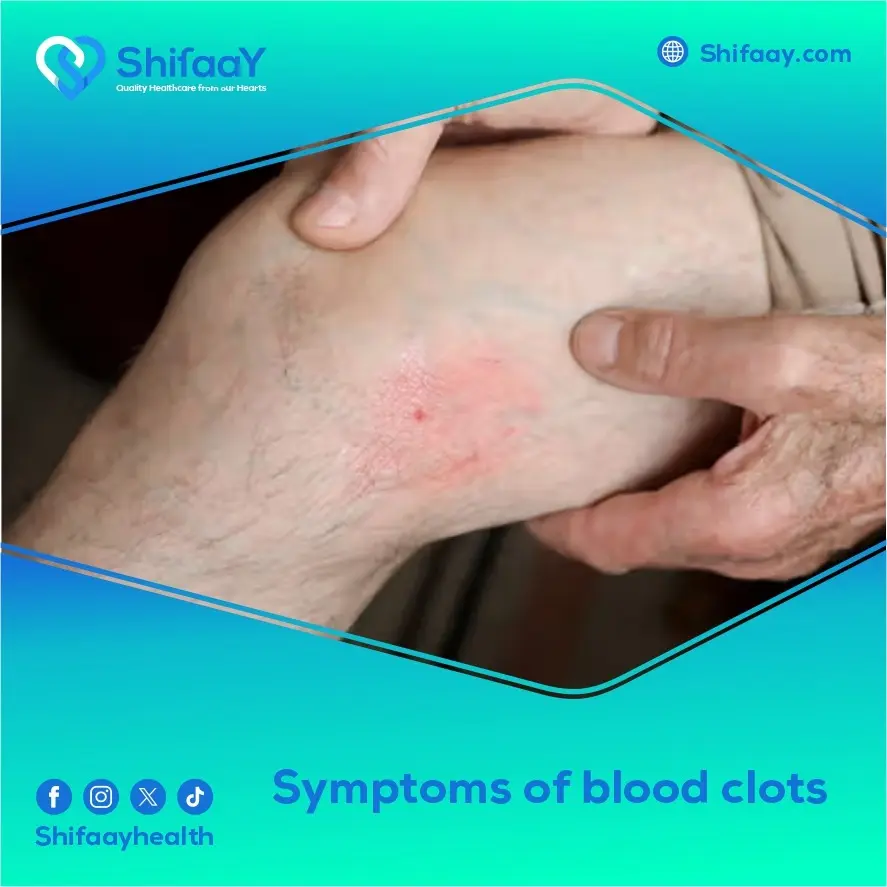
Imagine a tiny blood clot forming in a vein or artery without you noticing—then suddenly, it moves and blocks the blood flow to one of your vital organs like the heart, lungs, or brain. In a matter of seconds, a person’s life could completely change. That’s why Shifaay Healthcare Center presents this important section to help you become more aware of the early, mild symptoms of blood clots, so you can stay prepared and protect your life or that of your loved ones.
Before diving into the symptoms, it’s important to understand that a mild blood clot may initially appear “silent,” but in reality, it could carry early warning signs that should not be ignored. These signs often present as mild or transient symptoms, but they can be indicators of serious danger if not recognized and addressed in time.
Here are the most common symptoms:
- Sudden numbness or weakness in the face, arm, or leg, especially on one side of the body.
- Sudden difficulty speaking or understanding others, as if words are slurred or unclear.
- Visual disturbances, such as blurred vision or temporary loss of vision in one or both eyes.
- Sudden dizziness, loss of balance, or uncoordinated movements.
- A severe and sudden headache unlike any headache you’ve had before.
- Tingling or pins-and-needles sensation in one limb, which may come and go.
- Unexplained fatigue that appears suddenly, even without exertion.
- Chest pain or shortness of breath, particularly if the clot is near the lungs.
Read aslo: Carotid Endarterectomy (CEA)
Symptoms of a Mild Stroke
Symptoms of a mild stroke are critical warning signs that should never be ignored. They serve as an early alarm from the body, indicating the presence of a serious condition that could escalate into a full-blown stroke, potentially threatening a person’s life. These symptoms are often temporary and may last only a few minutes or hours, which leads some people to dismiss them or attribute them to fatigue or general exhaustion — a mistake that could prove fatal.
A mild stroke, also known as a transient ischemic attack (TIA), might actually be the body’s golden opportunity to seek treatment before it’s too late. Therefore, recognizing these symptoms and responding quickly can make a significant difference in protecting the brain from permanent damage or loss of vital neurological functions.
Shifaay Healthcare Center, recognized as the leading medical tourism center in Egypt, is committed to raising individual and community awareness about these warning signs. It provides immediate and specialized medical services for anyone experiencing similar symptoms, ensuring timely intervention and reducing the risk of future complications.
Here are the most important symptoms of a mild stroke:
- Sudden numbness or weakness in the face, arm, or leg — especially on one side of the body.
- Difficulty speaking or sudden slurred speech.
- Confusion or inability to understand language normally.
- Loss of balance, dizziness, or lack of motor coordination.
- Sudden vision problems in one or both eyes.
- Sudden severe headache with no known cause, possibly accompanied by nausea or vomiting.
- Difficulty walking or a sensation that the body is not responding properly.
Symptoms of Blood Clots in Women
Symptoms of blood clots in women are a serious health issue that often requires immediate awareness and urgent medical intervention. The signs of a clot in women can differ significantly from those in men, which often results in delayed diagnosis and treatment. Interestingly, many women may experience symptoms that indicate danger but fail to recognize them as signs of an impending stroke or heart attack, as they may appear in the form of mild pain or temporary fatigue — which increases their risk.
Raising awareness and providing clear, direct information is essential for every woman concerned about her health or the health of her loved ones.
Below are the key symptoms of blood clots in women that should be taken seriously and prompt an immediate visit to Shifaay Center:
- Sudden, severe fatigue or generalized weakness for no apparent reason, especially if localized to one side of the body.
- Unusual chest pain — sharp or dull — accompanied by shortness of breath or a feeling of suffocation.
- Shortness of breath, even at rest or with minimal effort.
- Sudden dizziness or loss of balance, possibly with difficulty walking or speaking clearly.
- Sharp pain in one or both arms — especially the left arm — that may radiate to the jaw, back, or neck.
- Sudden nausea or vomiting without an obvious digestive cause — a misleading symptom in many women.
- Sudden changes in vision in one or both eyes.
- Sudden numbness or tingling in the face, arm, or leg, particularly on one side of the body.
- Sudden behavioral changes or difficulty speaking or understanding speech.
Symptoms of a Stroke Triggered by Emotional Distress
We must acknowledge that stroke symptoms caused by emotional distress are an important topic that often sparks curiosity and demands immediate attention. Not only due to their unusual presentation but also because of the medical facts they carry — facts that may surprise many people. Can emotional distress really cause a stroke? The answer is yes.
Research has shown that intense psychological stress and strong emotional reactions, such as sudden grief or emotional shock, can lead to physiological changes in the body that increase the risk of blood clots, especially in individuals with pre-existing conditions or chronic illnesses.
Doctors at Shifaay Healthcare Center explain that emotional distress leads to a surge in stress hormones such as cortisol and adrenaline. These hormones can cause blood vessels to constrict, raise blood pressure, and increase blood clotting. This chain reaction can, in some cases, result in a blockage in one of the body’s vital arteries — whether in the brain, heart, or lungs — causing a potentially life-threatening stroke.
Because early intervention in such cases can be life-saving, here are the most important symptoms of blood clots related to emotional distress to watch for:
- Sudden numbness or weakness in a limb, particularly the arm or leg on one side of the body.
- Sudden, severe headache, possibly with nausea or altered consciousness.
- Sudden difficulty in speaking or slurred speech.
- Shortness of breath or sharp chest pain.
- Visual disturbances such as double vision or temporary loss of sight.
- Loss of balance or unexplained dizziness.
Symptoms of Blood Clots in the Hand
Symptoms of blood clots in the hand may initially appear to be a minor health issue, but they can signal serious complications if not detected and treated promptly. Blood clots often obstruct blood flow to the tissues of the hand and fingers, potentially leading to nerve or tissue damage. In more severe cases, the clot can travel to the lungs or heart, posing a life-threatening risk.
The danger lies in the fact that the symptoms of a clot in the arm can resemble those of less serious conditions, leading many people to ignore them or delay seeing a doctor—thereby losing precious time that could prevent complications. For this reason, early recognition of blood clot symptoms in the hand and taking immediate medical action is crucial to preserve healthy blood circulation and the overall function of the hand.
Common symptoms of a blood clot in the hand include:
- Sudden or gradual swelling in the hand or arm, often accompanied by a feeling of heaviness or tightness.
- Persistent or recurring pain in the arm or hand that worsens with movement or touch, and may resemble a muscle cramp.
- Redness or skin discoloration, where the hand may appear bluish or purple due to impaired blood flow.
- Localized warmth in a specific area of the hand, noticeable when touching the affected spot, and distinct from the rest of the skin.
- Tingling or persistent numbness in the fingers or palm, resembling the sensation of pins and needles or temporary loss of feeling.
- Prominent or tight veins under the skin, caused by blood pooling and difficulty returning to normal circulation.
Read aslo: root canal treatment
Symptoms of Blood Clots in the Leg
Blood clot symptoms in the leg are among the most critical health issues that require immediate attention. They are not simply passing discomfort or swelling—they may indicate a life-threatening condition if not diagnosed and treated early. A blood clot in the leg, medically known as Deep Vein Thrombosis (DVT), can lead to severe complications if not managed urgently. One of the most dangerous is the potential migration of the clot to the lungs, causing a pulmonary embolism, which can be fatal. Thus, being aware of early symptoms can make a vital difference between safety and danger.
- The most prominent signs of a blood clot in the leg include:
- Unexplained swelling in one leg, usually not both.
- Cramping or throbbing pain in the leg, which intensifies with walking or standing.
- Skin discoloration, turning reddish or bluish.
- Warmth or heat in a specific area of the leg.
- Visible, engorged veins or a heavy sensation in the affected leg.
- Sudden shortness of breath or chest pain, especially if the clot has moved to the lungs.
The Difference Between a Clot and Coagulation
The difference between a clot (thrombus) and coagulation is often misunderstood, despite its importance in health awareness and risk prevention. Understanding this distinction can be the key to making the right decision and avoiding dangerous delays. Both terms involve the formation of a blood clot within vessels, but the difference lies in context and consequences.
Coagulation is a natural and beneficial process that occurs to stop bleeding when an injury happens. Platelets and clotting proteins in the blood work together to form a clot that prevents excessive blood loss.
The real danger arises when this clotting process occurs abnormally inside blood vessels without injury, turning a protective mechanism into a health risk by obstructing blood flow and potentially causing serious complications.
A clot (thrombosis), on the other hand, is a pathological condition caused by abnormal coagulation that blocks blood flow in vital organs such as the heart (heart attack) or brain (stroke).
Blood clot symptoms usually appear suddenly, including numbness in a limb, difficulty speaking, or severe chest pain, and require immediate medical attention.
In short, a blood clot is one of the most dangerous outcomes of abnormal coagulation, and prevention starts by understanding coagulation itself and monitoring its triggers, such as heart disease, lack of physical activity, and smoking.
Symptoms of Blood Clots in the Elderly
Blood clot symptoms in the elderly can be especially dangerous, often developing silently without warning signs. They may not always come with the typical pain or discomfort but may appear as subtle symptoms mistaken for fatigue or normal aging. However, the reality can be far more serious. A small clot in the leg can travel to the lungs or brain, causing a fatal blockage within minutes. Thus, raising awareness of blood clot symptoms in seniors is not a luxury but an essential step—especially for those with chronic conditions such as diabetes, hypertension, or heart problems.
Key symptoms of blood clots in elderly individuals include:
- Unexplained swelling in one limb, particularly in the leg or arm, often painful to the touch.
- Sharp or throbbing pain in the affected limb, which may worsen when walking or moving.
- Skin discoloration, turning blue or purple in the area of the clot.
- Localized warmth when touching the affected area, compared to other parts of the body.
- Shortness of breath or rapid heartbeat, which may indicate the clot has moved to the lungs.
- Sudden dizziness or loss of balance, especially if the clot has affected cerebral circulation.
- Sudden chest pain, possibly accompanied by profuse sweating or nausea.
Symptoms of Blood Clots in the Abdomen
Symptoms of blood clots in the abdomen are considered a medical emergency that can be life-threatening if not treated promptly and correctly. These clots often lead to a blockage in the blood supply to vital parts of the intestines or other internal organs, resulting in tissue damage and potentially serious complications such as gangrene or sepsis.
What makes abdominal blood clots particularly dangerous is that their symptoms often resemble those of other gastrointestinal conditions, making timely and accurate diagnosis crucial. For this reason, it’s essential for everyone to be aware of these symptoms, as hesitation in seeking medical care or ignoring abdominal pain can lead to dire consequences. The most important symptoms include:
- Sudden and severe abdominal pain that does not go away over time.
- Nausea or vomiting with no clear cause.
- Unexplained abdominal bloating or a sensation of fullness.
- Bloody diarrhea or visible blood in the stool.
- Fever accompanied by abdominal symptoms.
- Weakness or dizziness caused by low blood pressure due to internal bleeding.
- Slowed or stopped bowel movements.
- Pain that radiates from the abdomen to the back or shoulder.
How to Prevent Blood Clots

Preventing blood clots has become one of the most pressing health concerns in our modern era, as clots are now a leading cause of sudden death or permanent disability across various age groups. This is largely due to modern lifestyles characterized by physical inactivity, high stress levels, obesity, and the rising prevalence of chronic conditions such as diabetes and hypertension. What makes clots especially dangerous is their tendency to occur without clear symptoms, which makes prevention absolutely essential.
That’s why Shifaay Healthcare Center always prioritizes your safety and provides the most reliable methods and medical advice to help you prevent blood clots and stay protected. These include:
- Staying active: Avoid prolonged sitting, especially during travel or desk jobs. Perform simple foot and leg exercises every hour to stimulate blood circulation.
- Drinking enough water: Dehydration increases blood viscosity and the likelihood of clot formation.
- Wearing compression stockings: Particularly if you’re at risk or in post-surgical recovery periods.
- Taking anticoagulant medications as prescribed: If your doctor recommends blood thinners, never stop taking them without medical advice.
- Maintaining a healthy weight and avoiding smoking: Obesity and smoking significantly raise the risk of developing clots.
- Following a heart-healthy diet: Include foods that naturally support blood flow, such as garlic, ginger, and omega-3-rich fish.
- Seeking immediate medical care: Don’t ignore sudden leg pain, swelling, or unexplained shortness of breath—these could be early signs of a serious clot.
By following these steps and monitoring your health through Shifaay Healthcare Center, which offers top-tier prevention programs and early screening services, you can live a safer, more reassuring life—away from the hidden dangers of preventable blood clots.
Read aslo: Treating toothache in children
How Do I Know It’s the Beginning of a Clot?
A blood clot often starts with sudden symptoms such as numbness or weakness in a limb, difficulty speaking or understanding, severe dizziness, or loss of balance. If you experience any of these symptoms, you should go immediately to Shifaay.
Signs of a Minor (Mild) Clot
A mild clot may cause short-term symptoms such as slight tingling, minor weakness in the hand or foot, temporary difficulty speaking, or blurred vision. These symptoms may disappear within minutes or a few hours, but they are still a warning sign that requires medical follow-up.

